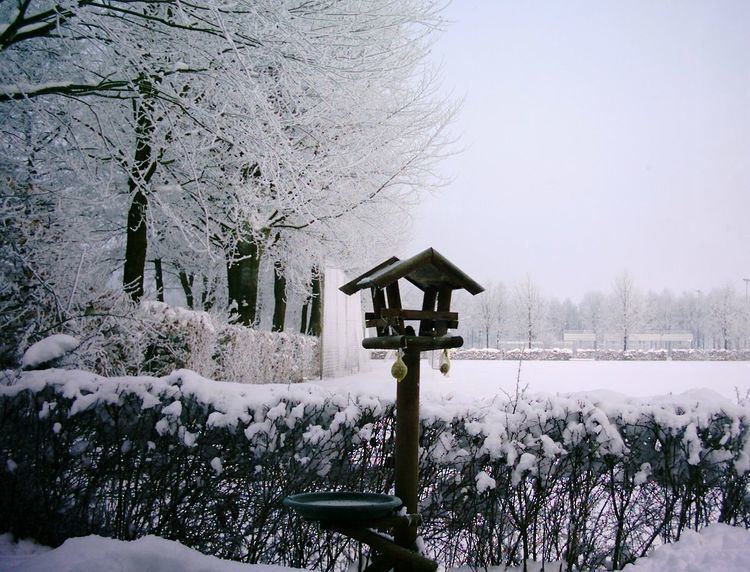 | ||
Bird feeding is the activity of feeding wild birds, often by means of a bird feeder.
Contents
History
James Fisher wrote that the first person recorded as feeding wild birds was the 6th-century monk Saint Serf of Fife who tamed a pigeon by feeding it. During the harsh winter of 1890-1891 in the United Kingdom national newspapers asked people to put out food for birds. In 1910 in the United Kingdom, Punch magazine declared that feeding birds was a "national pastime." Bird feeding has grown into the United States' second most popular hobby behind gardening. To celebrate the bird feeding hobby, February was named National Bird-Feeding Month by congressional decree in 1994.
Activity
Bird feeding is typically thought of as an activity of bird enthusiasts. People who feed wild birds often attempt to attract birds to suburban and domestic locations. This requires setting up a feeding station and supplying bird food. The food might include seeds, peanuts, bought food mixes, fat, kitchen scraps and suet. Additionally, a bird bath and grit (sand), that birds store in their crops to help grind food as an aid to digestion, can be provided.
Feeding bread to waterfowl at parks, lakes and rivers is also a popular activity.
Types
Certain foods tend to attract certain birds. Finches and siskin will be attracted by Niger, and jays love corn. Hummingbirds, sunbirds and other nectivorous birds love nectar. Mixed seed and black oil sunflower seed is favoured by many seed-eating species. Birds such as white-eyes, barbets, and some thrushes will take fresh and cut fruit. Different feeders can be purchased specialized for different species.
Garden birds can be fed using peanuts, seed, coconut (but never desiccated coconut) or fat (but not oils that are liquid at room temperature) using a variety of feeders.
After the station is established, it can take some weeks for birds to discover and start using it. This is particularly true if the feeding station is the first one in an area or (in cold-winter areas) if the station is being established in spring when natural sources of food are plentiful. Therefore, beginners should not completely fill a feeder at first. The food will get old and spoil if it is left uneaten for too long. This is particularly true of unshelled foods, such as thistle seed and suet. Once the birds begin taking food, the feeder should be kept full. Additionally, people feeding birds should be sure that there is a source of water nearby. A bird bath can attract as many birds as a feeding station.
Impact
A study conducted in Sheffield, England, found that the abundance of garden birds increased with levels of bird feeding. This effect was only apparent in those species that regularly take supplementary food, raising the possibility that bird feeding was having a direct effect on bird abundance. In contrast, the density of feeding stations had no effect on the number of different bird species present in a neighbourhood.
The use of bird feeders has been claimed to cause environmental problems; some of these were highlighted in a front-page article in The Wall Street Journal.
Prior to the publication of the Wall Street Journal article, Canadian ornithologist Jason Rogers also wrote about the environmental problems associated with the use of bird feeders in the journal Alberta Naturalist. In this article, Rogers explains how the practice of feeding wild birds is inherently fraught with negative impacts and risks such as fostering dependency, altering natural distribution, density and migration patterns, interfering with ecological processes, causing malnutrition, facilitating the spread of disease and increasing the risk of death from cats, pesticides, hitting windows and other causes. In the UK, an experimental study providing supplementary food during the breeding season found that predation levels were higher when nests were located within close proximity to filled feeders.
In a paper in the journal Oecologia, it was reported that feeding of blue tits and great tits with peanut cake over a long time period significantly reduced brood size. This was driven by smaller clutch sizes in both species and lower hatching success rates for blue tits. Studies by the University of Freiburg and Environment Canada found that blackcaps migrating to Great Britain from Germany had become adapted to eating food supplied by humans. In contrast blackcaps migrating to Spain had bills adapted to feeding on fruit such as olives.
Economy
Large sums of money are spent by ardent bird feeders, who indulge their wild birds with a variety of bird foods and bird feeders. Over 55 million Americans over the age of 16 feed wild birds and spend more than $3 billion a year on bird food, and $800 million a year on bird feeders, bird baths, bird houses and other bird feeding accessories. The activity has spawned an industry that sells supplies and equipment for the bird feeding hobby.
In some cities or parts of cities (e.g. Trafalgar Square in London) feeding pigeons is forbidden, either because they compete with vulnerable native species, or because they abound and cause pollution and/or noise.
